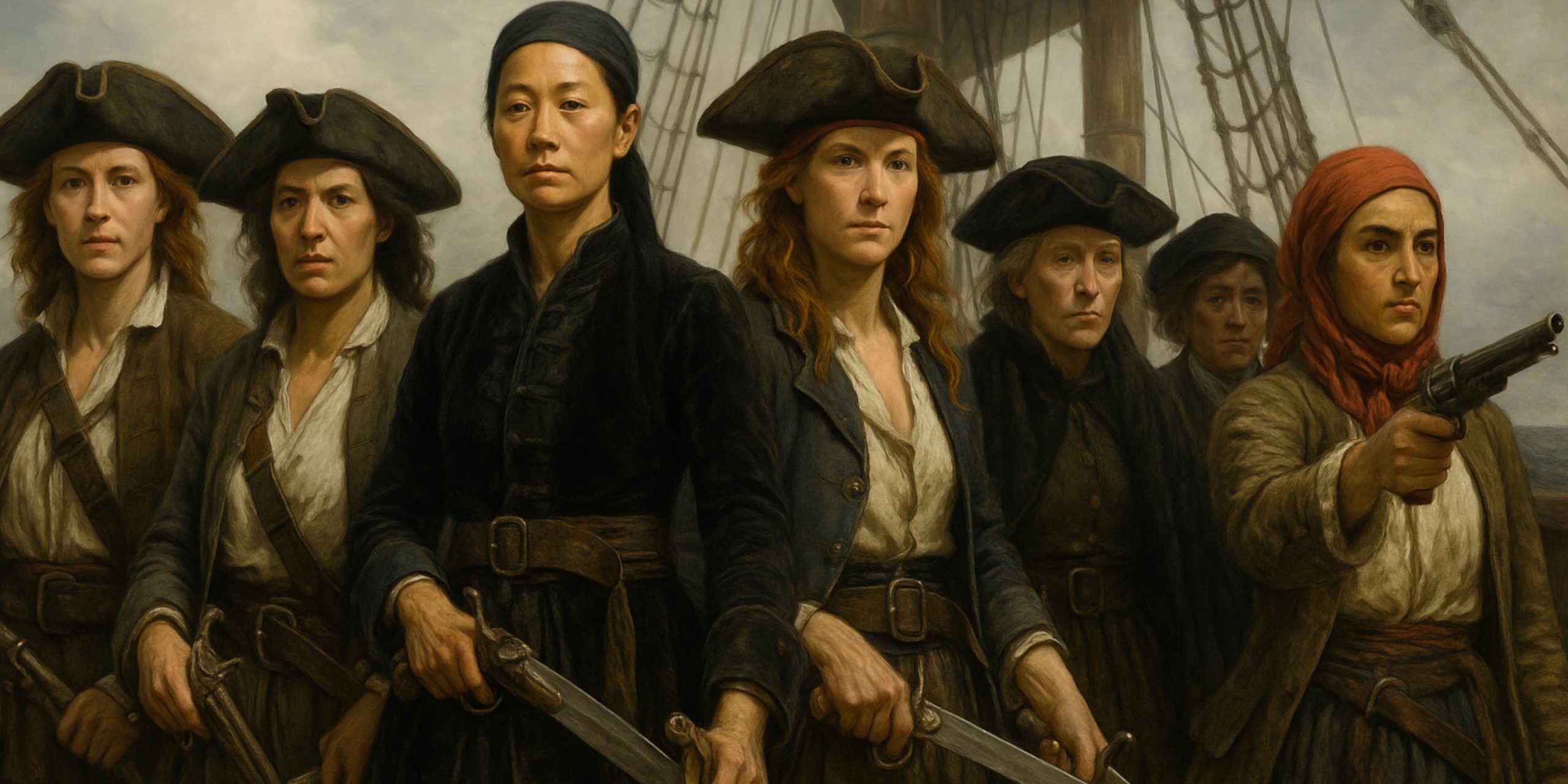
Piracy was not just a man’s world. Across centuries of sea battles, mutinies, and rum-soaked legends, women carved their own place in maritime history. Some disguised themselves as men to survive in brutal naval cultures. Others commanded fleets so large they made entire empires nervous. These women were outlaws, opportunists, and sometimes reluctant symbols of rebellion.
Let’s set sail through history’s most notorious female pirates, whose lives were as fierce as the tempests they rode.
Anne Bonny
Anne Bonny’s story reads like an 18th-century fever dream of chaos, romance, and swordplay. Born in Ireland and raised in the Carolinas, she fell in with the pirate Calico Jack Rackham and joined his crew disguised as a man. Once revealed, her presence was tolerated, largely because she fought harder than most of the men on deck.
When captured in 1720, Bonny was sentenced to hang but claimed pregnancy to delay execution. Her last recorded words to Rackham were cutting: “Had you fought like a man, you need not be hang’d like a dog.” Her fate after imprisonment remains uncertain, though legends say she escaped and lived quietly. Somehow that feels unlikely.
Mary Read
Mary Read shared a fate and a ship with Anne Bonny. Raised as a boy to secure an inheritance, she lived much of her early life under disguise. She served in both the British military and pirate ranks with equal enthusiasm.
When captured alongside Bonny, Read was also pregnant, buying her temporary mercy. Unlike Anne, she died in prison, likely from fever. Together they became a strange kind of myth: two women who broke every rule in an age that barely acknowledged them.
Ching Shih
If there were a crown for piracy, Ching Shih would have worn it. A former Cantonese prostitute turned pirate queen, she commanded over 70,000 men and more than 1,500 ships in the early 19th century. The British, Portuguese, and Qing navies all tried to stop her and failed miserably.
Ching Shih wasn’t just ruthless. She was shrewd. She imposed a code of conduct that would make a naval officer proud: no theft from locals, no violence against female captives, and instant execution for those who disobeyed. When she finally retired, it was not to a noose but to a life of comfort. She lived out her days running a gambling house, which feels poetically appropriate.
Watch the documentary:
Grace O’Malley
Long before the Caribbean corsairs, there was Grace O’Malley, the 16th-century Irish pirate queen who ruled the seas off Connacht. She was born into a noble seafaring family and refused to bow to English control.
Grace led raids, traded with Spain, and even met Queen Elizabeth I face to face. The two women, worlds apart in rank but equal in willpower, reportedly negotiated terms while Grace refused to bow, claiming she recognised no queen but herself. The English were not impressed. Ireland, on the other hand, never forgot her.
Jeanne de Clisson
A Breton noblewoman turned avenger, Jeanne de Clisson’s story is less swashbuckling and more cold-blooded. After her husband was executed for treason in 1343, she sold her estates, bought warships, and spent the next 13 years hunting French vessels in the English Channel.
Known as the “Lioness of Brittany”, Jeanne executed captured nobles personally, leaving a single survivor to spread the message. It was medieval revenge at sea, and oddly efficient.
Rachel Wall
Often described as America’s first female pirate, Rachel Wall’s story is a strange blend of poverty, crime, and saltwater. Born in Pennsylvania, she ran away to sea with her husband and began luring ships to wreck on the New England coast. When the unsuspecting sailors came ashore to help, she and her crew robbed them blind.
Eventually captured in 1789, she was hanged in Boston. Her final words reportedly asked God to forgive her. The public, as usual, preferred the spectacle.
Sayyida al-Hurra
Operating from the Moroccan coast in the 16th century, Sayyida al-Hurra was both a pirate and a ruler. After losing her family to Spanish conquest, she turned to privateering, forming alliances with the infamous Barbarossa brothers of the Ottoman fleet.
Her control over the Mediterranean trade routes made her a political force, not just a maritime threat. Even after being overthrown, her legend remained strong. The title “al-Hurra” itself means “the free woman”, a name she earned through defiance and dignity.
Fanny Campbell
Fanny Campbell’s life straddles the line between truth and folklore. In the mid-19th century, she disguised herself as a man named “William” to rescue her fiancé from imprisonment in Cuba. During the journey, she apparently captured a ship and turned it to piracy.
Her tale spread in pamphlets and penny novels, becoming part of American maritime folklore. Whether every word was true hardly mattered. The image of a woman commanding a ship in the Caribbean stuck firmly in public imagination.
The Seven Swords Takeaway
From the Atlantic to the South China Sea, these women defied the expectations of their time with cutlasses, cunning, and courage. Some fought for survival, others for vengeance, and a few simply for the thrill of it.
Their lives blur the line between myth and history, but one thing is clear: they were not passengers on history’s voyage. They steered it, one storm at a time.



